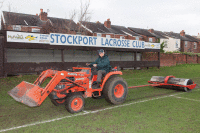Stockport Lacrosse Club - growing the sport

It is true to say that, in the past, it has been the private sector schools which have been the main domain of the sport of lacrosse, but this is fading now. However, the primary school system is looking to redress this by taking the fun level of the sport - Pop Lacrosse - into their sports curriculum, which could hopefully move back into secondary schools as these youngsters grow. In the meantime, the main field version remains strong in the universities and clubs.
In the female version, the game is officially a non contact sport, to a fashion, as you can still knock the ball out of the opponent's stick, you just cannot knock your opponent over, at least not while the ref is looking, and bear in mind there are two of them!
Talk to most ladies and they will tell you that the women's game is more skillful than the men's. This is probably both true and false in equal measures. As mentioned, the physical element is substantially toned down, the sticks themselves are more difficult to catch and throw with, and there are more rules that you have to adhere to.

However, the basis of the game is the same; teams are divided into attack, midfield and defence, all have a stick of varying lengths, with a netted plastic head used to throw, catch and carry a solid rubber ball, with the eventual aim of scoring past the goalkeeper, stood in his six feet square net, protected by a nine feet radius called a crease where no other player may enter.
Lacrosse dates back many hundreds of years when it was a game played by Native American tribes and originally known as stickball.

Games were played for a number of reasons - as a sport that toughened up young warriors for war, but also simply for recreation as well as religious reasons. It was not unusual for bets to be placed on the outcome of games.

A couple of hundred years later, a demonstration of lacrosse was given by the Caughnawaga Indians in Montreal. As a result of this, interest in the game began to develop in Canada, with the Montreal Lacrosse Club being founded in 1856. A decade later, rules were drawn up which included reducing the number of players, introducing a rubber ball and a redesigned stick, the basis of which form the modern game.
By 1860, lacrosse had become Canada's national game and, in 1867, exhibition games were played in England. In 1876, Queen Victoria watched a game being played and remarked that "the game is very pretty to watch".
In 1883, a touring team from Canada and and a team made up of Iroquois natives visited Scotland. Obviously, border controls were not as tight then as they were in 2010 as, due to a diplomatic row over passports, the Iroquois nation never actually competed in that year's World Championships in Manchester, denying the UK of seeing one of the best lacrosse playing nations in the world.
The sport is now played in many countries throughout the world, but its heartland is still in North America where the game is played to a professional level.

Due to the popularity of the game in England, there remains many different forms of contact between the UK as a whole and the USA. Most clubs have a US player who not only plays competitively but also acts as what is termed an LDO - Lacrosse Development Officer - tasked with doing just that, developing the game in local schools and often the junior section of their designated club. They are allocated by the governing body of Lacrosse in England - the English Lacrosse Association - a member of FILA, the Federation of International Lacrosse and the overseer of all things lacrosse in England.
In addition, there are various programmes run whereby juniors are selected from all of the clubs in the area to represent and play for that area, both in the UK and the US, on either a two or four year programme. These fortunate young people gain fantastic experience living with their host families whilst on their two week tour, playing against various opposition as well as playing for their home club against the touring Americans on their return visit, culminating, on this side of the Atlantic, with the UK v US end of tour game at Stockport Lacrosse club. These games are played here due to it, probably surprisingly, being the oldest lacrosse club in the world. It also sits in the heartland of English men's lacrosse.

The Senior Flags victory of 1896 was the start of the first of two all conquering periods. For eight consecutive seasons - from 1896 to 1903 - Stockport swept aside all opposition to win the Flags, a record that has not been equalled since. In the same period, the Iroquois Cup and First Division Championship were both won six times.
A major trophy of the period remains in the possession of the Club. This is the Flags Final Challenge Flag, which was won outright in 1898. The flag is a large, finely detailed embroidered trophy depicting two lacrosse players dressed in the kit of the period stood on each side of a shield, with the winning clubs of the previous seasons scrolled on each side. The Challenge Flag is permanently on display in the clubhouse.
More recently, the current first team have been sweeping all aside and a four year unbeaten run came to an end only recently.
Les Grainger, a very important figure in Stockport's history, laid the foundations for this success and, up to five or six years ago, all players were home grown. However, success breeds success as we all know and, just like in any sport, amateur or pro, to make the national team you need to be noticed and have the ability to play to your potential, which often requires good players alongside you.

Pitchcare caught up with Barry Livesey who, like many in this entirely amateur status game in the UK, wears many different hats and, not only works free of charge as a groundsman to the lacrosse section, but is a very hands-on and possibly autocratic chairman of the committee running the club as a whole. The club is made up of three different sports sections, each paying a levy to the club and each responsible for their own sports specific equipment, with the club responsible for more general matters when it comes to ground maintenance.

Barry has never been a lacrosse player but, having played football, he took his transferable skills and managed junior teams whilst his children played; a notion many parents will be able to identify with. In fact, they all played to county level, an achievement Barry seems rightly proud of.

Barry is 71 now and has been looking after the ground for over thirty years and has never had any formal training; everything has been self taught. Originally, the plan was for him to retire at 70, however these plans did not come to fruition when Barry's wife decided that she did not want him cluttering up the house, so he still visits the club most days.
The methods of work have changed considerably in these thirty years. In the early days, the grass was mown using a gang mower towed on the back of Barry's car! Nowadays, the club has two small tractors to do the towing and there is a ride on mower as well.

Monday morning and Barry can be seen on the ground rolling the pitch flat again after the weekend's battles. He does take pride in making it look as nice as possible. In addition, he spikes and slits as he remembers being told once that this aeration encourages root growth. There is a train of thought within the club to play wherever possible, and Barry is often fighting with himself over the decision to play or not. In one respect, wanting to keep the damage to the pitch at a minimum but, on the other hand, to not deny the players a chance to play.
Generally, he comes to the decision that there is no point having a pristine pitch if no one is ever allowed to play on it; it does somewhat make it a pointless exercise. So an awful lot of sand is used to keep the mud at bay at the risk of limited new growth. Fortunately for Barry, this sand spreading is now much easier with a mechanical scoop on one of the tractors filling the spreader, which can be then towed by the other tractor.
P

The pitch is solely used for lacrosse, mainly at weekends, for both men's junior and senior games (the ladies and girls play on another pitch) but is also let out to local schools. It is not used a great deal in the summer other than the previously mentioned American crossover games for both boys and girls, including being the training venue for the Americans, so repairs tend to wait until then. The main areas of the creases (the circular area around the goal), the wings and the centre - areas which get a great deal of traffic - are scarified and then the application of grass seed and soil, nothing more complicated than that. Turfing of the worst affected areas was tried once, but failed, probably due to the need for sanding.
Although Barry does not have any staff or a nominated assistant, players do help at reseeding time, and the cricket groundsman assists, wherever possible, with Barry reciprocating during the summer. Pest and weed control is also done annually by outside contractors, but this is generic maintenance as, so far, the grounds have not suffered from any specific disease outbreaks. The pitch is also fertilised on an annual basis.

Although the club does not have an official environmental policy in place, the needs of local flora and fauna are considered wherever possible.
Barry does have one concern, and that is for the future. There is nobody waiting in the wings to take over. The group of volunteers who took over in 1996 are all getting on and some have even passed away. Although a lot of the required hard work has now been done regarding the club as a whole, there is still the ongoing running and ground maintenance.
Barry feels that volunteers are a dying breed; a sad state of affairs at sports clubs throughout the country. Players expect a surface on which to play their sport, but don't expect to do anything to make this surface ready for play, and this is no different here at Stockport lacrosse.

The negatives are not what Barry will take away from the club he has spent so many years involved with - and hopes to continue to do for many years to come - whether that is running it, looking after the pitch or watching his sons play. He told me that he and his supportive wife who also assist in the club, have made many friends through his involvement with the club and lacrosse in general, friends he will keep for life.
Words and images by Martyn Cartledge www.aspphotography.net

